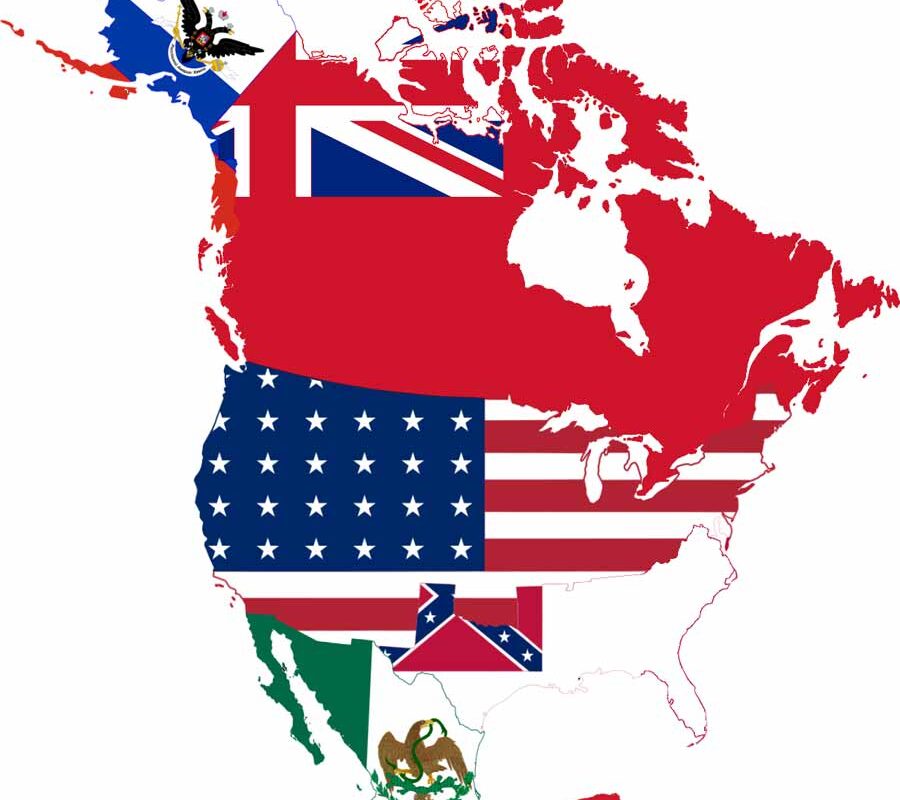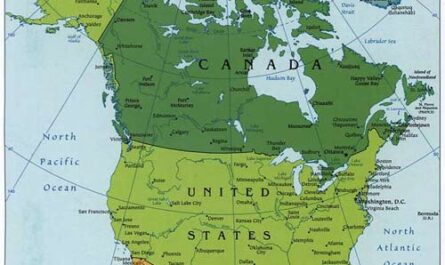North America, a continent ensconced entirely within the Northern Hemisphere and predominantly situated in the Western Hemisphere, assumes the role of a northern subcontinent within the broader Americas. Its geographical boundaries are both intriguing and vast, stretching northward to the Arctic Ocean, eastward to the Atlantic Ocean, and southeastward to meet South America and the Caribbean Sea. Meanwhile, the western and southern peripheries are defined by the vast expanse of the Pacific Ocean. An exception to this continental demarcation is the inclusion of Greenland, primarily due to its geographical allegiance to the North American Tectonic Plate.
The Arctic Embrace: Northern Boundary
To the north, North America shares an intimate affiliation with the Arctic Ocean, its icy embrace influencing the region’s climate and ecological dynamics. The Arctic, with its frigid waters and floating ice masses, serves as both a geographical boundary and a climatic influencer. This northern extremity paints a picture of resilience and adaptation, as the continent grapples with the challenges posed by its polar neighbor.
Atlantic Enchantment: Eastern Border
The eastern frontier of North America is kissed by the Atlantic Ocean, a vast expanse of marine majesty that has played a pivotal role in shaping the continent’s historical narratives. The ebb and flow of Atlantic currents have facilitated maritime trade, cultural exchanges, and ecological interplay. The coastal regions along the Atlantic serve as a testament to the confluence of human civilization and the untamed allure of the ocean.
Southward Odyssey: The Dance with South America and the Caribbean
As North America extends southeastward, it engages in a dance with the landmass of South America and the azure embrace of the Caribbean Sea. This intercontinental rendezvous brings forth a mosaic of diverse landscapes, from the dense rainforests of Central America to the pristine beaches dotting the Caribbean archipelago. The geographical interplay between these regions encapsulates the intricate choreography of nature’s design.
Pacific Horizons: Western and Southern Frontiers
On the contrasting side of the continent, the western and southern boundaries of North America dissolve into the vastness of the Pacific Ocean. This expansive aqueous realm not only defines the geographic limits of the continent but also serves as a canvas for breathtaking seascapes and marine biodiversity. The coastal regions along the Pacific bear witness to the harmonious coexistence of land and water, with diverse ecosystems thriving in the coastal intertidal zones.
Greenland’s Geographical Quandary
The inclusion of Greenland in the North American tapestry adds a layer of complexity to the continent’s geographical narrative. Situated on the North American Tectonic Plate, Greenland defies a clear-cut continental boundary, straddling the realms of North America and the Arctic. Its icy landscapes and glacial expanses contribute to the mosaic of North America’s geographical diversity, highlighting the intricate interplay of tectonic forces and natural formations. RPM 3.0 – 60% CONVERSION & Money for Affiliate Marketing
Countries in North America and Their Capitals
Countries in North America and Their Capitals (According to Country’s Alphabetic Order)
| Country | Capital |
|---|---|
| Anguilla | The Valley |
| Antigua And Barbuda | Saint John’s |
| Aruba | Oranjestad |
| Bahamas | Nassau |
| Barbados | Bridgetown |
| Belize | Belmopan |
| Bermuda | Hamilton |
| British Virgin Islands | Road Town |
| Canada | Ottawa |
| Cayman Islands | George Town |
| Costa Rica | San José |
| Cuba | Havana |
| Curacao | Willemstad |
| Dominica | Roseau |
| Dominican Republic | Santo Domingo |
| El Salvador | San Salvador |
| Greenland | Nuuk |
| Grenada | St. George’s |
| Guadeloupe | Basse Terre |
| Guatemala | Guatemala City |
| Haiti | Port Au Prince |
| Honduras | Tegucigalpa |
| Jamaica | Kingston |
| Martinique | Fort De France |
| Mexico | Mexico City |
| Montserrat | Plymouth |
| Nicaragua | Managua |
| Panama | Panama City |
| Puerto Rico | San Juan |
| Saint Barthélemy | Gustavia |
| Saint Kitts And Nevis | Basseterre |
| Saint Lucia | Castries |
| Saint Martin | Marigot |
| Saint Pierre And Miquelon | Saint Pierre |
| Saint Vincent And The Grenadines | Kingstown |
| Sint Maarten | Philipsburg |
| Trinidad And Tobago | Port Of Spain |
| Turks And Caicos Islands | Cockburn Town |
| United States | Washington D.C. |
| United States Minor Outlying Islands | |
| United States Virgin Islands | Charlotte Amalie |
Countries in North America and Their Capitals
Countries in North America and Their Capitals (According to Capital’s Alphabetic order)
| Country | Capital |
| United States Minor Outlying Islands | |
| Guadeloupe | Basse Terre |
| Saint Kitts And Nevis | Basseterre |
| Belize | Belmopan |
| Barbados | Bridgetown |
| Saint Lucia | Castries |
| United States Virgin Islands | Charlotte Amalie |
| Turks And Caicos Islands | Cockburn Town |
| Martinique | Fort De France |
| Cayman Islands | George Town |
| Guatemala | Guatemala City |
| Saint Barthélemy | Gustavia |
| Bermuda | Hamilton |
| Cuba | Havana |
| Jamaica | Kingston |
| Saint Vincent And The Grenadines | Kingstown |
| Nicaragua | Managua |
| Saint Martin | Marigot |
| Mexico | Mexico City |
| Bahamas | Nassau |
| Greenland | Nuuk |
| Aruba | Oranjestad |
| Canada | Ottawa |
| Panama | Panama City |
| Sint Maarten | Philipsburg |
| Montserrat | Plymouth |
| Trinidad And Tobago | Port Of Spain |
| Haiti | Port Au Prince |
| British Virgin Islands | Road Town |
| Dominica | Roseau |
| Antigua And Barbuda | Saint John’s |
| Saint Pierre And Miquelon | Saint Pierre |
| Costa Rica | San José |
| Puerto Rico | San Juan |
| El Salvador | San Salvador |
| Dominican Republic | Santo Domingo |
| Grenada | St. George’s |
| Honduras | Tegucigalpa |
| Anguilla | The Valley |
| United States | Washington D.C. |
| Curacao | Willemstad |

Other recommended reading
- 125 Fun Facts about Malaysia for Curious Minds
- 150 Interesting Facts about Ireland for Travelers
- 200 Interesting Facts about Spain for Everyone
- 200 Interesting Facts about Austria – Past and Present
- 200 Interesting Facts about Denmark
- 100 Interesting Facts about Ethiopia, Africa
- 200 Interesting Facts about New Zealand
- 100 Interesting Facts about Mongolia – Glory and Conquer
- 100 Interesting Facts about Taiwan – Past and Present
- 100 Interesting Facts about Russia – Past to Present
- Country Currency List – International Currencies | Currency Codes
More Interesting Articles
- 100 Cool Facts about Japan for Curious Learners
- 100 Interesting Facts About China to Know About
- 100 Venice, Italy Facts – Fun Facts about Venice
- 100 Top Interesting, Evergreen Facts about Nepal
- Largest Banks in the World – Big Banks with Reputation
- Top 100 Medical Colleges in the World
- The List of World’s Top 100 Universities
- 40 Interesting Facts about Beautiful Pokhara, Nepal
- List of Current United States Senators of the Congress
- The States in Alphabetical Order – Names of States in the USA
- 60 Interesting Facts About Morocco for Beginners
- 100 Top Interesting Facts About South Korea for Beginners
- 50 Interesting Cape Town South Africa Facts
- 30 Amazing Tokyo Tower Fun Facts for Learners
- 60 Fun Facts about Barcelona for Curious Minds
- 100 Interesting Facts About Rome for Avid Learners
- 100 Top Interesting Facts about Ghana for Everyone
- 20 Interesting Facts About Bandung, Indonesia
- 23 Interesting Facts About Nagoya Japan
- 18 Facts About National Palace Museum, Taiwan




